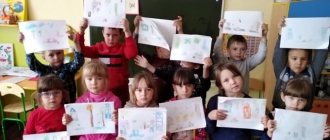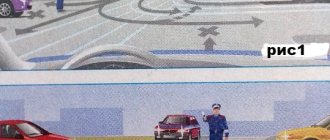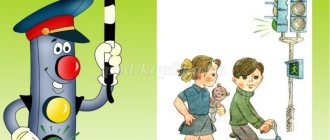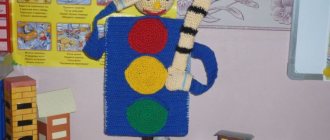Experience in studying traffic rules in preschool educational institutions
Presentation on the topic “We know without a doubt the rules of the road”
Every year in our country the number of road accidents is growing, and children are becoming their victims more and more often.
Our kindergarten pays special attention to this problem. In this regard, we have identified the main goals and objectives of the work to prevent child road traffic injuries. We believe that children should be introduced to the road alphabet from a young age. Based on programs: - N.N. Avdeeva, O.L. Knyazeva, R.V. Sterkina “Fundamentals of the safety of preschool children”, one of the directions of which is the section “Child on the street”; — Textbook “teaching preschool children the rules of safe behavior on the roads” regional standard; - “Teaching junior schoolchildren the rules of safe behavior on the road”, edited by R.N. Minnikhanova, D.M. Mustafina, we have developed individual planning for each age group. This is not the first year that our institution has been working in this direction: a regulatory framework for the prevention of DDTT has been developed, educators collect didactic material, develop manuals, make educational games and models with their own hands, organize joint activities (holidays and entertainment with the participation of children and parents, thematic conversations, excursions). (6 slide) Children’s knowledge of traffic rules will be effective only if the theory is closely related to practice. The most effective method of teaching children the basic rules of behavior on the road is a game in which they themselves participate. Being carried away by it, children learn the basic requirements of the rules and understand who pedestrians, drivers, and traffic controllers are. Teachers in each age group have created road safety corners in accordance with the age of the children and the requirements of the program. In the younger group, in the traffic rules corners, children play and acquire knowledge that on the city streets there are large and small houses, a road and a sidewalk, and that the concepts of “street” and “road” are distinguished. While playing with cars, they learn to distinguish between cars and trucks, learn the rules of behavior in transport, on the sidewalk, when crossing the road, that the main thing on the road is a traffic light. In the middle group there is a corner with an intersection. Children, while playing, get acquainted with the elements of markings “zebra”, “dividing line”, one-way two-way traffic. During the role-playing game, children learn the rules of crossing the roadway and learn that there are signs on the roads that warn pedestrians and drivers about what awaits them ahead. This group uses not simple, but “live”, emotional road signs. The main work on teaching children traffic rules continues in the senior and preparatory groups. The content of the material in these groups is more complex: in the corners there are various types of intersections with markings, sidewalks, traffic stops, and various types of signs. Children become familiar with the concept of a “safety island” and means of traffic control. Children of this age already have a certain amount of knowledge and ideas about their surroundings. Therefore, the main direction of work is intellectual and playful activity in the form of entertaining games, logical tasks, puzzles, crosswords, which develop intelligence, attention, and independence. It should be noted that training in traffic rules is also carried out in classes in various types of activities (drawing, design, speech development, theater activities, music classes, physical education classes). The creation of a subject-development environment is of great importance in organizing role-playing games. For this purpose, we have an autoclass where a street model is made, intersections and signs for pedestrians are marked, and there are models of houses, shops, and pharmacies. This is a place where children not only play, but also at the same time practice and consolidate their knowledge of the rules of behavior for a cultured pedestrian and driver, road signs, and work together with the teacher on situational road safety tasks. The work of a preschool institution in teaching children the rules of safe movement can only be effective if it cooperates with parents on this issue. When organizing such cooperation, it is important to remember that it should not be declarative and didactic in nature. Therefore, when carrying out work on the prevention of children's road traffic injuries with the families of pupils, we build contact so that parents, from passively receiving information, become active in the process of assimilating it. In one case, an individual dialogue with individual parents will be more justified, in the other, familiarity with publications from the local and central press. A frequent guest at our preschool educational institution is the Chief Specialist of the Directorate for Financing Scientific and Educational Programs of Road Traffic Safety of the Republic of Tatarstan Yulia Mikhailovna Saferova, she discusses the problems of children's road traffic injuries, conversations containing practical advice and recommendations for parents on teaching children the rules of safe behavior while walking, specific traffic accidents involving children are examined. For the same purpose, in the parent corners of each age group there is illustrative material and recommendations for parents on the prevention of road traffic injuries. To increase the interest of parents and children in the road alphabet, we organize various types of leisure activities: quizzes, competitions, holidays. Thus, it has become a good tradition at the end of the school year to hold a competition “For the best drawing on road safety”, the obligatory requirement of which is the joint activity of an adult and a child. To help educators organize teaching children traffic rules, an educational and methodological complex has been created in the methodological classroom of the kindergarten: didactic and demonstration material, lesson notes, educational videos, card files of conversations and walks, games, poems, riddles, long-term plans for introducing children to traffic rules movements in accordance with the age of the children. To identify the level of education of children in terms of knowledge of road traffic, we use pedagogical diagnostics. The assessment results are compared with acceptable criteria so that educators plan further individual work with each child. It is impossible to instill the skills of safe behavior on the road only by talking about caution. A child should be taught safe behavior and traffic rules from the moment he begins to walk independently. A preschooler has children's toys and children's books, but he does not have the skills to behave safely on the road. Therefore, when teaching children the basics of “traffic literacy”, the teaching staff of preschool educational institutions adheres to the following rules : - do not mechanically memorize traffic rules with children, but instill in preschoolers a culture of behavior on the road. — combine the study of the Rules with the development of children’s coordination, attention, and observation skills. - use all available forms and methods of work, not considering some form to be the main one, and some to be secondary. A story and a game, a quiz and drawing, a practical lesson and showing videos, reading a book and an excursion are all necessary to develop children's skills for safe behavior on the road.
We recommend watching:
Entertainment according to traffic rules in the middle group of kindergarten. Scenario Scenario of entertainment according to traffic rules for children of primary preschool age Scenario of entertainment according to traffic rules for children of the 1st junior group Summary of a lesson on traffic rules in kindergarten
Similar articles:
Lesson notes for junior group 1. Traffic Laws
Traffic rules holiday in the preparatory group
Traffic rules in kindergarten. Senior – preparatory group
Lesson notes on traffic rules for the senior group. Signs in a person's life
Lesson notes on traffic rules for the senior group. Why are road signs needed?






